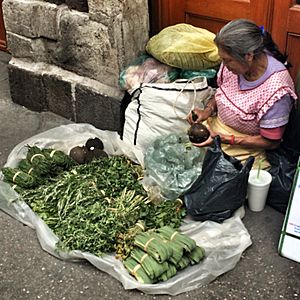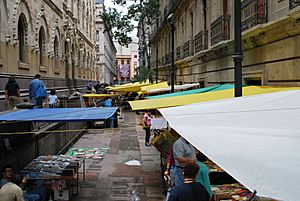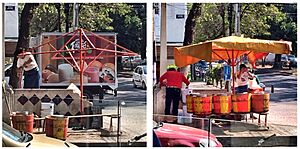Street vendors in Mexico City facts for kids
The presence of street vendors in Mexico City (called ambulantes in Mexican Spanish) has a long history, going all the way back to before the Spanish arrived. For centuries, the government has tried to manage these vendors. For example, in 2007, many vendors were cleared from downtown streets. Even with these efforts, thousands of street vendors continue to operate, sometimes without official permission. Selling goods on the street is common not just in Mexico but in many parts of the world. In 2003, it was estimated that there were nearly 200,000 street vendors in Mexico City.
Contents
A Look Back: History of Street Vending

Before the Spanish came to Mexico, most buying and selling happened in special marketplaces called tianguis. These were big, open-air markets.
Early Street Sellers
After the Spanish took over, street vendors, then called buhoneros, started appearing outside the main markets in places like the Zócalo square. The city government tried to control these sellers very early on, even as far back as 1541, by making it illegal for them to move around and sell.
Growth and New Rules
The number of street vendors grew a lot in the 1970s and 1980s. In 1993, a big effort began to reduce street vending in the Historic Center of Mexico City. About 10,000 vendors were moved from the streets into new indoor markets called plazas comerciales. The idea was to help them follow tax rules and health guidelines.
In 1998, new rules were made to try and organize street selling. This was called the Programa de Reordenamiento del Comercio en Via Publica, which means "Program for Reordering Trade in Public Streets." However, street vending kept growing. Efforts to remove vendors often failed because they would just return to the streets.
Recent Changes and "Toreros"
During the 1990s and 2000s, street vendors sometimes paid money to groups, often called "unions," to be allowed to sell on a sidewalk spot without official city permission. These groups would then try to influence city officials to let the vendors stay.
Finally, in October 2007, the streets of the Historic Center were largely cleared of vendors. This was seen as a big success for the mayor at the time, Marcelo Ebrard. However, some sellers, known as toreros (meaning "bullfighters"), still operate. These vendors sell items from a tarp on the ground that can quickly be folded into a bag. This allows them to pack up their goods and leave quickly if police arrive.
Different Kinds of Street Vendors and What They Sell
Street vendors sell items in many different ways. You might see them selling from:
- Baskets, often with sandwiches or tacos.
- Pushcarts, selling fresh fruit or coconut water.
- The back of trucks, offering fruit or even toilet paper.
- A tarp or cloth spread on the ground.
- Small stalls.
Vendors who use stalls can be part of different setups:
Organized Markets
- Tianguis and mobile markets (mercados sobre ruedas): These are like farmers' markets that set up in a specific place on certain days of the week. They have a fixed schedule and are checked by city inspectors to make sure things like weights and measurements are fair. These markets help provide food to the city.
Vendor Groups
- Concentrations: These are areas where many vendors set up stalls, often specializing in certain products. For example, you might find many stalls selling imported electronics in Tepito, or auto parts, tools, and clothes in other areas. Even if these vendors don't move around much, they are still often called ambulantes. You can also find groups of stalls near metro stations or hospital entrances.
- Bazaars (plazas comerciales): These are indoor shopping areas where vendors with a similar "theme" (like stationery) are gathered. Many of these were created to give a place for vendors who used to sell on the street.
- Individual or small groups of stalls can also be found on almost any city sidewalk.
How Many Street Vendors Are There?


Studies have tried to count the number of street vendors in Mexico City.
Recent Numbers
A study from 2013 focused just on the Historic Center of Mexico City and found:
- About 25,000 vendors.
- Informal vendors were present on 150 blocks.
- 70% of the toreros (quick-pack vendors) came from the State of Mexico.
- About 60 different groups or organizations controlled the vendors.
A study in 2003 by INEGI (Mexico's statistics agency) showed there were 199,328 street vendors in Mexico City itself.
Mid-1990s Estimates
A study from the mid-1990s estimated the numbers like this:
- Total full-time street vendors: 185,600. This number didn't include people who sell only sometimes or during busy seasons, which could add 50% more vendors.
- Concentrations (stalls on streets/sidewalks): 1,500 stalls (not counting 10,500 stalls in empty lots).
- Rotating Markets (like tianguis): 38,000 stalls.
- Ambulatory (moving around): 67,248 stalls.
- Near Metro stations: 5,000 stalls.
- Street corners/neighborhoods: 10,000 stalls.
- Total stalls: 121,738.




